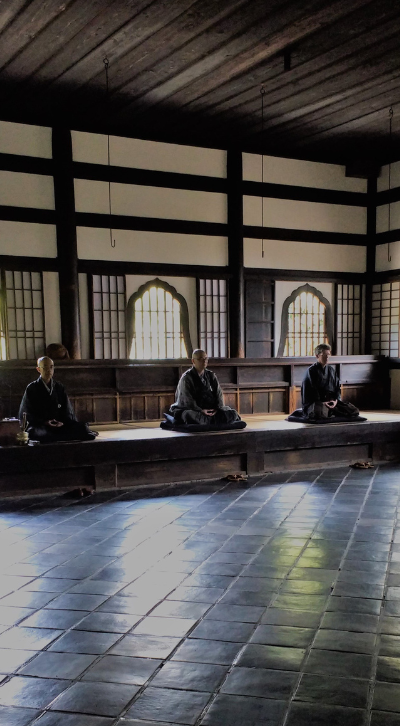
About ISCR
What is Contemplative Research?
We understand contemplative research to be the scholarly and scientific investigation of meditative and other mind-body practices and their clinical and pedagogical applications. Such research includes the study of traditional and modern techniques that cultivate or focus attention in a sustained fashion with the aims of deepening concentration, tranquility, and insight; broadening our understanding of the many forms of consciousness including nondual awareness, all with the larger goal of promoting well-being. The spectrum of contemplative research is wide-ranging. It includes work on developing prosocial capacities and dispositions such as empathy, compassion, and kindness; the study of everyday “flow” experiences of absorption in an activity; enactive approaches to the study of cognition; psychological and philosophical inquiry into the nature of mind and the conditions that foster human flourishing; interdisciplinary inquiry into the social and ethical dimensions of contemplative practices, including their relevance to issues of social justice, conflict resolution, and holistic education; phenomenological descriptions of meditative, psychedelic, and otherwise induced states of consciousness, together with scientific investigation of their neurobiological and behavioral correlates, aimed at deriving basic knowledge and evaluating potential clinical applications; and scholarly study of the most profound and life-changing experiences that have been deliberately and systematically cultivated in various religious and philosophical traditions.




Contemplative research may also examine Mind and Body practices, including a large and diverse group of techniques, exercises, or other practices involving systematic training of mind, integration of embodied, embedded, and/or enactive forms of cognition, and techniques that manipulate bodily systems with the intention of healing or otherwise contributing to a flourishing physical, mental, and emotional constitution. Various forms of meditation, yoga, taiji, and qigong are examples of Mind and Body practices (see https://www.nccih.nih.gov/health/mind-and-body-practices).
Contemplative research may also involve investigation into aspects of wellbeing, including a sense of purpose, meaning, ways of knowing and experiencing the world, altruistic forms of motivation, love, kindness, compassion, gratitude, forgiveness, and philosophical understanding of the self, no-self, wisdom, and the nature of suffering.
Contemplative research may also investigate the role of contemplative practices in the advancement of social justice, racial equity, and conflict resolution.
Society Information
Founding Statement
International Society for Contemplative Research: Rationale, Purpose, Objectives
Harold D. Roth, Ph.D
Professor of East Asian Religions and Director of the Contemplative Studies Initiative and Concentration, Brown University, Providence, RI | USA
Over the past few decades, as the awareness of the transformative potential of contemplative practices has grown in our cultures, many people have been working away in separate and siloed academic fields on scholarship and research into these practices and their results. Far too often we have had to carry out this research and scholarship in relative isolation from one another and often at the fringes of what each of our separate fields considered respectable. We have had to deal with criticisms of our research and teaching by colleagues with relatively narrow views of what constitutes viable research and scholarship in our fields.
The past 30 years of research findings have documented the beneficial effects of contemplative practices on cognitive, social, emotional, physiological, clinical, and educational domains of human experience. This work stems from the efforts of three largely distinct groups: scientists within the clinical sciences and cognitive neuroscience; scholars and researchers in the various humanities, social sciences and education, and contemplative practitioners working in all these groups. All have been intrigued by the possibility of uncovering the core mechanisms of action and meaning by which contemplative training may impact the realization of our full potential as human beings, and by the integrative potential of contemplative training to inform the development of more inclusive models of mind, brain, and body interactions in the context of health, disease, performance, and human flourishing. Yet, despite of this productivity, the development of contemplative research has been impeded by fundamental conceptual and methodological challenges that jeopardize its longevity. Many of these are caused by the existing intellectual silos in the Academy that divide the empirical sciences from one another and from the humanities, social sciences and education. Because of this, the potential for a cumulative humanistic science that cultivates and integrates these previously siloed academic approaches has not yet been fully realized, and the need for standards and benchmarks for multidisciplinary approaches to engage in contemplative research remains.
We establish the International Society for Contemplative Research in the hope that such an association of liked-minded contemplative scholars will be critical in building research communities of mutual support that will enable all stakeholders to work together to overcome these difficulties and to formulate the foundations and methods for this important new academic field. We propose that over the longer term, ISCR will support disciplinary, interdisciplinary, and multi-disciplinary field building and field-sustaining initiatives needed for our scholarly community to form, to develop, and to thrive.
I firmly believe that those who are afraid to test existing paradigms never make truly significant advances in human knowledge. And we now face so many challenges in this anthropocene era that we can no longer wait to put our professional resources together to see what we can collectively do to have a positive impact on this devolutionary direction in which our world is heading. Our students, our children, our grandchildren are growing up in a world dominated not just by the threat of environmental demise but filled with the trendy post-modern nihilism that Paul Ricouer once called the “hermeneutics of suspicion.” They live in a world in which hype and reality have become hopelessly confused. They live in a world in which delving into the deepest levels of human potential cannot easily compete with the siren call of social networking. They live in a world in which it becomes increasingly easier to revert into tribal divisions rather than discover what it is that connects us in the human community.
By working together both within and across academic silos, Contemplative Scientists, Humanists, Social Scientists and Educators, can communicate some of the idealism and compassion that has led each of us into our respective fields, to a troubled world in desperate need of precisely this kind of more positive vision of our collective identities and our interdependent futures.
We hereby extend an invitation for all like-minded scholars, researchers, and contemplatives to join us in this important field-building effort. It is our fervent hope that by combining our resources, our vision, and our enthusiasm for this innovative, silo-busting endeavor, we will ultimately have a greater effect on helping to create human societies that are more healthy, more just, more humane, and more equitable.
Bylaws
Bylaws of the
International Society for Contemplative Research (the “Society”)
Adapted: September 6, 2024
Organizational Structure
For ISCR, we chose an alternative organizational structure which better reflects our values of equality and diversity than the traditional hierarchical structure which has a President on top, with Vice-Presidents beneath. In this flat org structure, the society is steered by an Executive Committee composed of diverse representatives across all of our core academic disciplines. Key decisions are made consensually by the Executive Committee as a whole. Ideally, Executive Committee members will come from areas all around the world, including low-and middle-income countries, and be diverse not only across areas of study, but also demographically in terms of race, culture, gender, sexual orientation, etc… Executive Committee members can be junior or senior researchers with experience conducting contemplative research or scholarship.
From within the current Executive Committee, a “Director” for each discipline has been assigned. Their role is to liaise with others from their academic discipline around societal matters and help to grow membership within their discipline. In addition to the five core disciplines, we have two additional Directors, one with responsibility for finances and records, and another to assure our mission of interdisciplinarity is upheld in all our activities.
We have an executive manager who is in a paid position, and carries out day-to-day society tasks at the direction of the Executive Committee.
Below this is our committee structure, organized by the main tasks of the society, as well as an EDI committee which will assure all society activities incorporate key EDI principles. Committees are generally chaired by one or more EC members. Society members can volunteer to join any of these committees. Mandates, procedures and tasks will be defined as we develop Terms of Reference for each committee as it gets underway.
History
For many years, people who studied contemplative practices were marginalized in their own departments , but were able to collaborate with colleagues from other institutions in an informal manner. During the 1990s and 2000s, a number of conferences and workshops specific to mindfulness and contemplative neuroscience were convened, but it wasn’t until 2012 when the Mind and Life Institute took a major step towards creating a new interdisciplinary field of study, convening an international conference that, in retrospect, serves as a watershed moment in the creation of our new International Society for Contemplative Research
At this 2012 conference a group of colleagues from across disciplines came together and with the support of the Mind and Life Institute and created the first interdisciplinary International Symposia for Contemplative Studies (ISCS), held in Denver, Colorado to a sold-out audience. Because the inaugural conference was so successful, the Mind and Life Institute took the initiative to organize and run the conferences biannually. The 2014 conference in Boston focused on advancing our understanding of the human mind, and how training through contemplative practices can lead to valuable insights that reduce suffering and promote human flourishing through enhanced health, cognitive/emotional functioning, and social harmony. The third ISCS took place in 2016 in San Diego and it was marked by an increasing inclusion of humanistic epistemologies and social justice concerns, something found even further in the MLI International Research Institute Kyoto Japan in August of 2018 and later that year in the ISCS meeting in Phoenix. By the end of 2018 the ISCS had become the international flagship academic conference on the scientific and humanistic study of mindfulness, meditation, and other contemplative practices. But things were beginning to change.
In 2020, the event was re-focused towards an academic audience to more directly serve the science and research community. The International Symposia for Contemplative Studies became the Contemplative Research Conference (CRC) and was scheduled to be held on the University of Wisconsin campus. Given the challenges presented by the global pandemic, the conference had to quickly pivot to a virtual format. The newly branded 2020 Contemplative Research Conference brought together over 600 scientists, scholars, and contemplatives to share leading-edge insights
By this time, a robust community of researchers and scholars of contemplative studies was well established, and Mind and Life decided to “pass the baton” to a new organization that would be formed out of this growing community. This new organization would coalesce the considerable variety of academic disciplines and research specialization of its members around the principal focus of forging a new academic approach to the study of the full range of contemplative experiences and their potential to have a positive influence on the health and well-being of the human community. This new organization would not only put on conferences, but also provide further opportunities for interdisciplinary field-building.
In the spring of 2020, a group of scientists and humanists who had long been involved in the Mind and Life community and were the leaders of previous symposia met to launch the process of establishing an independent academic association. A subgroup then applied for and received funding for an MLI Think Tank to move this vision forward. Forty-two participants met for two full-days. Over 500 individual scientists and scholars from the extended community completed a short survey to provide insight into demographics, interests, and perceived value in starting such a multidisciplinary society. The results were overwhelmingly positive and supportive. Think Tank meetings in January and March of 2021, establishing the basic mission and vision for the new academic association. Following the Think Tank meetings, an Executive Committee was formed, the new association was officially named the International Society for Contemplative Research (ISCR), and incorporated as a nonprofit society, the mission and vision were finalized, and the website launched.
We now welcome you to join our energetic young society. There are plenty of opportunities to add your voice to the conversation and help shape the society as we grow the emerging field of contemplative research.
Think Tank Acknowledgements
Think Tank Planning Committee
Linda Carlson
Amishi Jha
Erin McCarthy
Hal Roth
Zindel Segal
Dave Vago
Fadel Zeidan
Think Tank Grant Advisors
Richie Davison
John Dunne
Norm Farb
Eric Garland
Sara Lazar
Cliff Saron
Think Tank Participants
CLINICAL | PSYCHOLOGY
Amit Bernstein
Marcelo Demarzo
Sona Dimidjian
Elissa Eppel
Lone Overby Fjorback
Eric Garland
Mellisa Rosenkrantz
Jonathan Schooler
Zindel Segal
Anne Speckens
Claudia Witt
NEUROSCIENCE
Aviva Berkovich-Ohana
Kalina Christoff
Richard Davidson
Gaelle Desbordes
Norman Farb
Amishi Jha
Sara Lazar
Antoine Lutz
Antonino Raffone
Andreas Roepstorff
Clifford Saron
Heleen Slagter
David Vago
M.K. van Vugt
Fadel Zeidan
HUMANITIES | SOCIAL SCIENCES | EDUCATION
Paula Arai
Bret Davis
Marc-Henri Deroche
John Dunne
Yuki Imoto
Thupten Jinpa
Sarah Mattice
Erin McCarthy
Chikako Ozawa-Da Silva
Roy Porat
Robert Roeser
Harold Roth
Sarah Shaw
Kimberly Shonert-Reichl
Judith Simmer Brown
Mark Singleton
Anne Valley
Diversity, Equity, Inclusion & Belonging
ISCR’s Commitment to Diversity, Equity, Inclusion, and Belonging
The International Society for Contemplative Research (ISCR) is dedicated to developing an organizational culture that is committed to embracing the principles of diversity, equity and inclusion. We believe in nurturing not only tolerance but moreover, appreciation and a sense of belonging, and we wish to assist in creating a world that both embraces our common humanity and celebrates a mutually respectful sharing of differences. We strive to foster and work with a global community that is diverse with respect to ethnicity, race, geography, socioeconomic status, gender, sexual orientation, ability, contemplative tradition, academic discipline, and worldview, among other sources of individual and communal difference. Our organization’s stakeholders will be dedicated to conducting and applying research to enhance the health and well-being of all, by addressing inequities in knowledge, access and outcomes related to contemplative practices.
We aim to realize this commitment to diversity, equity, and inclusion with the following concrete actions:
-
Fostering diversity, equity and inclusiveness in all of our events, research projects, trainings, publications and membership.
-
Committing to inclusion of a diversity of traditions, cultures, languages and practices, as well as academic diversity, in our membership, administrative structures, and programs.
-
Identifying and eliminating participation and retention barriers for diverse groups, especially those that have been underrepresented in the past.
-
Acknowledging and honoring the history and roots of contemplative practices in diverse spiritual and cultural traditions.
-
Continuously educating ourselves about the antecedents of social and economic inequality and how present structures and deficit-based belief systems can act to perpetuate injustice for oppressed groups, while maintaining power and privilege for dominant groups.
-
Continuously reflecting on our personal biases and privileges, and how we may unintentionally contribute to systems of oppression in our professional and personal lives, even as we seek to transform them.
Society Sponsor Opportunities
We invite you to consider making a financial sponsorship to support the ISCR’s growth and sustainability.
With your sponsorship, we can ensure that the ISCR remains a thriving hub for contemplative science and continues to drive transformative research and collaborations.
Take a look at the society sponsonship options that invest in maintaining, developing and supporting ISCR’s vision in contemplative research
Download Sponsorship Prospectus
Reach out to ISCR@podiumconferences.com with any questions.
The ISCR Logo

The logo of the ISCR depicts a tree within an open-ended circle. The all-encompassing yet non-reductive circle, called an ensō, is borrowed from Zen Buddhism, one of the many traditions in which the contemplative practices we study are rooted. The openness of the circle conveys a globally inclusive approach that is respectful of the historical and cultural origins of the variety of contemplative traditions and their modern extensions, emphasizing the diversity of voices and scholastic inquiries welcomed in our society.
The tree is a common symbol in many traditions, representing life, growth, wisdom, and spiritual as well as physical nourishment. The tree indicates that our study of contemplative practices is an evolving as well as collective effort, its growth balancing diversification and integration.
The branches represent the many academic disciplines our society encompasses and fosters dialogue among— education, social sciences, humanities, clinical sciences, neurosciences, and others. The tree in our logo also depicts the dendritic arbors of a neuronal tree, indicating our interest in the neurobiological bases of the mind and embodied contemplative experiences.
The trunk of the tree represents our shared commitment to the mission and vision of the society, rooted in our desire to provide a scholarly foundation for the holistic health and well-being contemplative practices engender.
We would like to thank for their Society Sponsorship 2025-2026:

